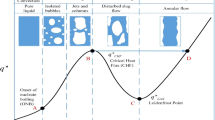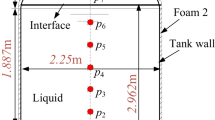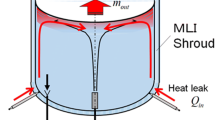Abstract
Hydrogen, as a space propellant, plays an important role in future space energy systems. However, it is sensitive to heat leakage from the environment because of its low boiling point and small density. Besides, the buoyancy convection is weakened and even completely suppressed in space microgravity environment. When there is heat leakage on the wall of the propellant tank, temperature stratification will be produced around the heat leakage source, resulting in propellant overheating. This will affect the interfacial heat and mass transfer, leading to pressure rise in the tank, and even endanger the structural safety of the system. To prevent tank pressure from rising above its design limits, venting or active pressure control techniques must be implemented. The cryogenic jet mixing is an effective method to suppress temperature stratification. The cryogenic fluid is mixed with the fluid inside the tank through a jet nozzle to reduce the thermal stratification and achieve uniform temperature distribution. In the present study, the temperature stratification phenomenon caused by heat leakage and its destratification via a cryogenic jet under microgravity condition were numerically investigated in the context of a partially liquid-filled large scale model tank. The effects of cryogenic jet mixing on the elimination of temperature stratification were analyzed for different initial filling ratios and mass flow rates. The results show that a higher incident mass flow rate can effectively destroy the temperature stratification inside the tank and promote an inside fluid flow for a given liquid filling ratio. A smaller filling ratio results in a faster growth in both average temperature and average pressure, and a larger amount of mass transfer inside the tank. It is more efficient to implement the cryogenic jet injection in the early stage when the remained propellant is still abundant, or adopt a higher incident mass flow rate to suppress the thermal stratification in the tank.




















Similar content being viewed by others
Data availability
The datasets generated and analyzed during the current study are available from the corresponding author on reasonable request.
References
Aydelott, J.C.: Normal gravity self-pressurization of 9-inch-(23 cm) diameter spherical liquid hydrogen tankage. NASA TN-D-4171 (1967a)
Aydelott, J.C.: Effect of gravity on self-pressurization of spherical liquid-hydrogen tankage. NASA TN-D-4286 (1967b)
Aydelott, J.C.: Effect of size on normal-gravity self-pressurization of spherical hydrogen tankage. NASA TND-5196 (1969)
Barnett, D.O., Mcreynolds, L .S., Winstead, T.W.: An investigation of liquid-hydrogen stratification in a large cylindrical tank of the saturn configuration. (1965)
Barsi, S., Kassemi, M.: Numerical and experimental comparisons of the self-pressurization behavior of an LH2 tank in normal gravity. Cryogenics 48, 122–129 (2008)
Brackbill, J.U., Kothe, D.B., Zemach, C.: A continuum method for modeling surface tension. J. Comput. Phys. 100(2), 335–354 (1992)
Grayson, G., Lopez, A., Chandler, F., Hastings, L., Brethour J.: CFD modeling of helium pressurant effects on cryogenic tank pressure rise rates in normal gravity. 43rd AIAA/ASME/SAE/ASEE Joint Propulsion Conference & Exhibit. (2007)
Guo, B., Zhao, J.F., Li, K., Hu, W.R.: Thermal destratification in hydrogen propellant tank in space by jet injection. Chinese Journal of Space Science. 40, 1052–1065 (2020)
Guo, B., Zhao, J.F., Li, K., Hu, W.R.: Numerical study on thermal destratification in large scale hydrogen propellant tank in space by jet injection under zero gravity condition. Chinese Journal of Theoretical and Applied Mechanics. 53, 1170–1182 (2021)
Hasan, M.M., Lin, C.S., Van Dresar, N.T.: Self-pressurization of a flight weight liquid hydrogen storage tank subjected to low heat flux. ASMWAICHE National Heat Transfer Conference. (1991)
Hastings, L.J., Plachta, D.W., Salerno, L., Kittel, P.: An overview of NASA efforts on zero boil off storage of cryogenic propellants. Cryogenics 41, 33–839 (2001)
Hochstein, J.I., Ji, H.C., Aydelott, J.C.: Effect of subcooling on the on-orbit pressurization rate of cryogenic propellant tankage. AIAA/ASME 4th Joint Thermo-physics and Heat Transfer Conference. Boston, Massachusetts, AIAA. (1986)
Hochstein, J.I., Ji, H.C., Aydelott, J.C.: Prediction of self-pressurization rate of cryogenic propellant tankage. J. Propul. Power 6, 11–17 (1990)
Kassemi, M., Kartuzova, O., Hylton, S.: Validation of two-phase CFD models for propellant tank self-pressurization: crossing fluid types, scales, and gravity levels. Cryogenics. 89 (2017)
Lee, W.H.: A pressure interation scheme for two-phase modeling. Technical Report LA-UR 79–975 Los Alamos Scientific Laboratory, Los Alamos, New Mexico, (1979)
Li, J.C., Lin, H., Zhao, J.F., Li, K., Hu, W.R.: Dynamic behaviors of liquid in partially filled tank in short-term microgravity. Microgravity Sci. Technol. 30, 849–856 (2018)
Li, J.C., Lin, H., Li, K., Zhao, J.F., Hu, W.R.: Liquid sloshing in partially filled capsule storage tank undergoing gravity reduction to low/micro-gravity Condition. Microgravity Sci. Technol. 32, 587–596 (2020a)
Li, J.C., Lin, H., Li, K., Zhao, J.F., Hu, W.R.: Dynamic behavior in a storage tank in reduced gravity using dynamic contact angle method. Microgravity Sci. Technol. 32, 1039–1048 (2020b)
Lin, C.S., Van Dresar, N.T., And Iiasan, M.M.: A pressure control analysis of cryogenic storage systems. AlAA Paper 91–2405 (1991)
Lin, C.S., Hasan, M.M.: Self-pressurization of a spherical liquid hydrogen storage tank in a microgravity environment. NASA TM 105372 (1992)
Ma, Y., Sun, P.J., Li, P., Li, Y.Z., Wang, L.: Numerical investigation on performance of spraying pressure control technique for liquid hydrogen tank at microgravity. Vacuum and Cryogenics. 24, 266–274 (2018)
Ma, Y., Li, Y., Zhu, K., Wang, Y., Wang, L., Tan, H.: Investigation on no-vent filling process of liquid hydrogen tank under microgravity condition. Int. J. Hydrogen Energy 42, 8264–8277 (2017)
Schmidt, A.P., Purcell, J.R., Wilson, W.A., Smith, R.V.: An experimental study concerning the pressurization of liquid hydrogen. Journal of research of the National Bureau of Standards. 65, 2 (1961)
Schepper, D., Sandra, C.K., Geraldine, J.: Modeling the evaporation of a hydro-carbon feedstock in the convection section of a steam cracker. Comput. Chem. Eng. 33(1), 122–132 (2009)
Wang, L., Li, Y., Li, C., Zhao, Z.: CFD investigation of thermal and pressurization performance in LH2 tank during discharge. Cryogenics 57, 63–73 (2013a)
Wang, L., Li, Y., Zhao, Z., Liu, Z.: Transient thermal and pressurization performance of LO2 tank during helium pressurization combined with outside aerodynamic heating. Int. J. Heat Mass Transf. 62, 263–271 (2013b)
Zuo, Z.Q., Sun, P.J., Jiang, W.B., Qin, X.J., Li, P., Huang, Y.: Thermal stratification suppression in reduced or zero boil-off hydrogen tank by self-spinning spray bar. Int. J. Hydrogen Energy 44, 20158–20172 (2019)
Acknowledgements
This research is supported by the Key Research Program of Frontier Sciences, CAS (Grant No. QYZDY-SSW-JSC040) and the National Nature Science Foundation of China (Gant No. 12172363, 11672311).
Funding
Key Research Program of Frontier Sciences,CAS,QYZDY-SSW-JSC040,Kai Li,National Natural Science Foundation of China,12172363,Kai Li,11672311,Kai Li
Author information
Authors and Affiliations
Corresponding author
Ethics declarations
Conflicts of interest
The authors declare no conflict of interest.
Additional information
Publisher's Note
Springer Nature remains neutral with regard to jurisdictional claims in published maps and institutional affiliations.
Rights and permissions
About this article
Cite this article
Li, JC., Guo, B., Zhao, JF. et al. On the Space Thermal Destratification in a Partially Filled Hydrogen Propellant Tank by Jet Injection. Microgravity Sci. Technol. 34, 6 (2022). https://doi.org/10.1007/s12217-021-09923-2
Received:
Accepted:
Published:
DOI: https://doi.org/10.1007/s12217-021-09923-2




